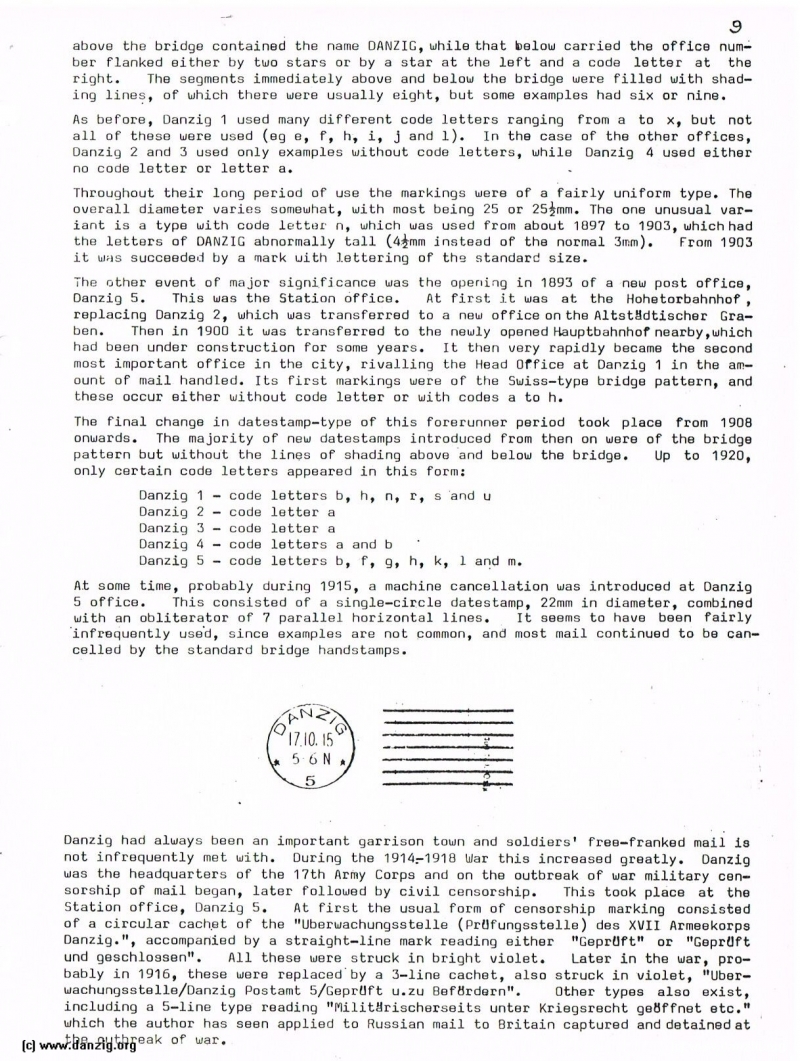
>> DANZIG: Postal History until 1920 - J. L. Whiteside
above the bridge contained the name DANZIG, while that below carried the office number flanked either by two stars or by a star at the left and a code letter at the right. The segments immediately above and below the bridge were filled with shading lines, of which there were usually eight, but some examples had six or nine.
As before, Danzig 1 used many different code letters ranging from a to x, but not all of these were used (eg, e, f, h, i, j and l). In the case of the other offices, Danzig 2 and 3 used only examples without code letters, while Danzig 4 used either no code letter or letter a.
Throughout their long period of use the markings were of a fairly uniform type. The overall diameter varies somewhat, with most being 25 or 25 mm. The one unusual variant is a type with code letter n, which was used from about 1097 to 1903, which had the letters of DANZIG abnormally tall (4 mm instead of the normal 3 mm). From 1903 it was succeeded by a mark with lettering of the standard size.
The other event of major significance was the opening in 1893 of a new post office, Danzig 5. This was the Station office. At first it was at the Hohetorbahnhof, replacing Danzig 2, which was transferred to a new office on the Altstädtischer Graben. Then in 1900 it was transferred to the newly opened Hauptbahnhof nearby, which had been under construction for some years. It then very rapidly became the second most important office in the city, rivalling the Head Office at Danzig 1 in the amount of mail handled. Its first markings were of the Swiss-type bridge pattern, and these occur either without code letter or with codes a to h.
The final change in datestamp-type of this forerunner period took place from 1908 onwards. The majority of new datestamps introduced from then on were of the bridge pattern but without the lines of shading above and below the bridge. Up to 1920, only certain code letters appeared in this form:
Danzig 1 — code letters b, h, n, r, s and u
Danzig 2 — code letter a
Danzig 3 — code letter a
Danzig 4 — code letters a and b
Danzig 5 — code letters b, f, g, h, k, l and m.
At some time, probably during 1915, a machine cancellation was introduced at Danzig 5 office. This consisted of a single-circle datestamp, 22 mm in diameter, combined with an obliterator of 7 parallel horizontal lines. It seems to have been fairly infrequently used, since examples are not çommuon, and most mail continued to be cancelled by the standard bridge handstamps
Danzig had always been an important garrison town and soldiers free-franked mail is not infrequently met with. During the 1914 - 1918 War this increased greatly. Danzig was the headquarters of the 17th Army Corps and on the outbreak of war military censorship of mail began, later followed by civil censorship. This took place at the Station office, Danzig 5. At first the usual form of censorship marking consisted of a circular cachet of the “Uberwachungsstelle (Prufungsstelle) des XVII Armeekorps Danzig.”, accompanied by a straight—line mark reading either “Gepruft” or “Gepruft und geschlossen”. All these were struck in bright violet. Later in the war, pro bably in 1916, these were replaced by a 3—line cachet, also struck in violet, “Ubewachungsstelle / Danzig Postamt 5 / Gepruft u. zu Befördern”. Other types also exist, including a 5-line type reading “Militärischerseits unter Kriegsrecht geöffnet etc.” which the author has seen applied to Russian mail to Britain captured and detained at the outbreak of war.
Danzig Report Nr. 30 - January - February - March - 1981, Page 9.
Hits: 4179
Added: 11/06/2015
Copyright: 2025 Danzig.org

